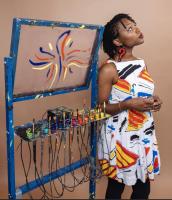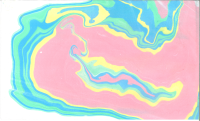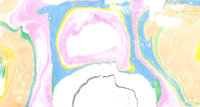Multidisciplinary artist Camry Ivory has been writing and performing music since childhood and has contributed to a variety of music projects and bands. Camry created a new instrument to explore the interplay between visual art and sound. Her interactive project, Coloratura, uses paint brushes assigned with specific tones to create paintings with their own unique sound signatures. Camry's artwork will be on display at the Gardner branch until August 21, 2023.
Introduce yourself and describe your work.
My name is Camry Ivory, and I'm a visual musician and the inventor of Coloratura, an audiovisual interface that enables me to create analog visual art and digital electronic music simultaneously. I'm passionate about merging artistic disciplines together to create multisensory, immersive experiences and this passion led me to ask: "What if I could create visual art simultaneously with my music?" What if I could play the color green or paint an Eb Major chord?" After months of searching for pre-existing technology that could bring this idea to life, my husband and I designed a set of “musical paintbrushes”. These brushes allow me to paint and generate sound at the same time, resulting in unique audiovisual soundscapes.
What instruments are used to compose each tone or sound?
Each paintbrush brush is assigned to a note in the musical scale; when a brush touches the canvas, it sends a signal to my computer to play a sound through Ableton, a music production software. Ableton has a vast database of sampled instruments and sounds that I can customize to create my own soundscapes; I also download samples from other sound artists or record and import my own sounds. During performances, I use various effects and loop pedals to create more complex compositions.

How has Coloratura changed since its inception and what hopes or plans do you have for its evolution?
I initially designed Coloratura to use in a one-time solo performance piece as a part of the Downtown Council of Kansas City's Art in the Loop series. I never imagined that the project would still be relevant almost 8 years later, but people’s fascination and enthusiasm for the project have driven its innovation. Though I designed Coloratura for my own solo performances, I really enjoy taking it to schools, workshops, and community centers, letting other people use it to create their own visual soundscapes. Everyone has a unique approach to using the paintbrushes and it's fascinating to see their creativity flow onto the canvas.
At the end of last year, I started changing the type of canvases I work with. Due to the technical nature of Coloratura, I initially had to paint on conductive surfaces to make the brushes create sound, so I was limited to painting on metallic surfaces or electrically conductive glass and plastic. I've recently developed a way to paint on various natural fabrics like silk, cotton & linen, and I've started experimenting with suminagashi, a form of Japanese water marbling that enables me to paint on water, which is naturally conductive.
I have so many plans for Coloratura’s future. I’m developing more versatile, user-friendly models that people can eventually use at home or in classrooms and I’m interested in collaborating with music and art therapists who can incorporate Coloratura in their practice. Ultimately, I want to inspire others to blur the boundaries between art and music and tap into their innate creativity.
Do you have a favorite experience with the Coloratura project?
My favorite experiences with Coloratura are when people really lean into the musical capabilities of the paintbrushes. In 2016, at the Kansas City Maker Faire, I met a woman who fully embraced the concept of Coloratura. She held several brushes in each hand and used them to create a phenomenal soundscape that I've never been able to duplicate. At a KC STEM Alliance event last year, two young girls used the Coloratura brushes to play in time with a passing marching band, intuitively tapping into the rhythm and coordinating their brushstrokes with the drum line’s beat.
What is your most important artistic tool? Is there something you can’t live without in your studio?
My computer is the most important tool that I use; this project could not exist without technology. Ableton, a music production software, is where I create all the sounds and effects that emerge as I paint. I also rely on my phone (aka my second brain) for its various apps, including Just Press Record for dictating my thoughts, Omnifocus for project management and Splice for quick video editing.
Ultimately, I think the most important tools, if you consider character traits as tools, are patience and humility. Because I have limited musical training and no formal art training, I spend a lot of time trying new things and learning from my failures. I have to be patient with the process and trust that I will find a solution to the technical and creative problems that emerge on a daily basis. I have to be humble and know when to ask for help when I'm in over my head. These traits are crucial to my success; without them, I would have abandoned this project a long time ago.
What books, movies and or music has inspired you recently?
I recently watched Sisters with Transistors, a documentary highlighting the stories of women in the early days of synth/electronic music like Daphne Oram, Laurie Spiegel and Suzanne Ciani. Though they were often misunderstood or dismissed for their visionary projects, their perseverance was inspiring and encouraged me to continue pushing forward with my own work.
I'm also a huge fan of the band Talking Heads and I recently finished David Byrne's book How Music Works. Byrne explores the historical origins of music in parallel with human culture and how, as our technology and cultural norms have adapted, music has adapted alongside it. He emphasized the inherently communal and collaborative nature of music, which has motivated me to seek out more opportunities for collaboration with Coloratura, instead of keeping the project so insular and isolated.





